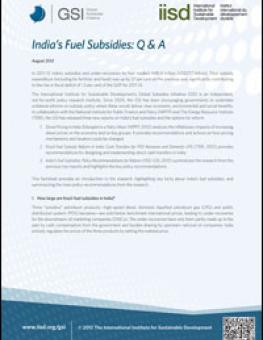
India's Fuel Subsidies: Q & A
This factsheet provides key facts about India's fuel subsidies and a summary of policy recommendations for reform.
The Government of India spent over US$ 9 billion subsidizing fuel products - diesel, kerosene, LPG and, to a lesser extent, gasoline - in 2010-11. The Government's total subsidy expenditure (including for food and fertilizer) increased by nearly 27% in 2011-12, significantly contributing to the deterioration of India's fiscal balance. In addition, national oil companies incurred over US$ 8 billion worth of under-recoveries.
The Government has announced its goal of reducing total subsidy expenditure to 2% of GDP in 2012-13, with further reductions down to 1.75% in following years. Yet reform has been hampered by legitimate concerns over how higher fuel prices will affect the broader economy—potentially disrupting key sectors like transport, industry and agriculture—and the ability of poor citizens to cope with higher prices.
The International Institute for Sustainable Development's Global Subsidies Initiative (GSI), in collaboration with Delhi-based research institutes the National Institute for Public Finance and Policy (NIPFP) and The Energy Resource Institute (TERI), have evaluated the impacts of phasing out diesel, LPG and PDS kerosene subsidies and examined cash-transfer schemes as a means to support poor citizens transition to higher fuel prices.
The research comprises the following reports:
- Diesel Pricing in India: Entangled in a Policy Maze (PDF - 1.22 MB), published by NIPFP, analyzes the inflationary impacts of increasing diesel prices on the economy and on key groups. It provides recommendations and actions on how pricing mechanisms and taxation could be changed.
- Fossil-Fuel Subsidy Reform in India: Cash transfers for PDS kerosene and Domestic LPG (PDF - 1.62 MB), authored by TERI, provides recommendations for designing and implementing direct cash transfers in India. (To be published on 21 August 2012)
- India's Fuel Subsidies: Policy Recommendations for Reform (PDF - 744 KB) , authored by IISD, summarizes the research from the previous two reports, and highlights the key policy recommendations. (To be published on 21 August 2012)
In addition, the IISD has produced a 6-page Questions and Answers document that distils the key findings and recommendations, available here (PDF - 338 KB).
For more background information about India's energy subsidies, see:
A Citizens' Guide to Energy Subsidies in India
The views expressed in these reports do not necessarily reflect those of the GSI's funders, nor should they be attributed to them.



